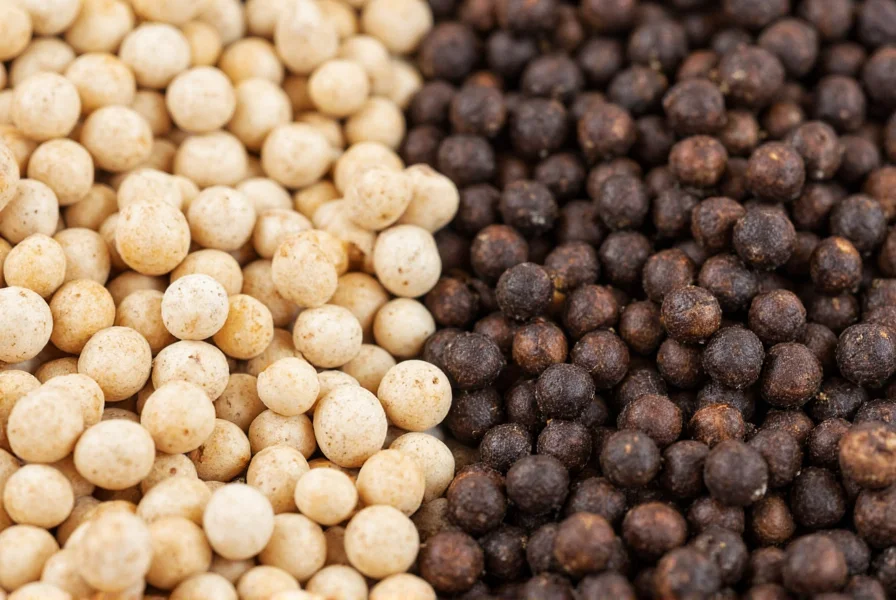Understanding the distinction between these common spices transforms your cooking. While many assume they're from different plants, the reality lies in harvest timing and processing methods. This knowledge helps you make informed choices in the kitchen, elevating everything from creamy sauces to grilled meats.
Origins and Processing Methods
Both white and black pepper originate from the Piper nigrum vine, native to South India. The critical difference emerges during harvesting and processing:
- Black pepper: Farmers pick unripe green berries, then sun-dry them. During drying, the outer layer (pericarp) turns black and wrinkled through enzymatic oxidation.
- White pepper: Producers wait until berries fully ripen to red, then either soak them to remove the outer layer before drying, or dry them first then remove the skin.
This processing difference explains their contrasting appearances and flavors. The outer layer contains most volatile oils responsible for black pepper's pungent aroma, while white pepper's removal of this layer creates a more subtle profile.

Flavor Profile Comparison
Understanding flavor differences helps determine which pepper works best for specific dishes. The following table outlines key characteristics:
| Characteristic | Black Pepper | White Pepper |
|---|---|---|
| Flavor intensity | Strong, complex, piney notes | Milder, earthier, slightly fermented |
| Aroma | Sharp, citrusy, floral notes | Subtle, musty, less aromatic |
| Heat level | Higher piperine content (more heat) | Lower piperine content (less heat) |
| Aftertaste | Clean, lingering warmth | Slightly musty, longer finish |
Culinary Applications
Chefs select between white and black pepper based on both flavor and visual considerations:
Black pepper shines in most applications where you want visible specks and robust flavor. It's ideal for:
- Steak seasoning and meat rubs
- Dark sauces and gravies
- Roasted vegetables
- Most spice blends (like garam masala)
White pepper serves specific culinary purposes where appearance matters:
- Creamy sauces (béchamel, alfredo) where black specks would show
- Light-colored soups and purees
- Asian cuisine (particularly Chinese and Vietnamese dishes)
- Some European dishes like vichyssoise

Nutritional Differences
Both peppers contain similar nutritional profiles since they come from the same plant. The primary active compound, piperine, appears in slightly higher concentrations in black pepper. This compound enhances nutrient absorption, particularly of curcumin in turmeric.
White pepper contains marginally less fiber since the outer layer (removed during processing) contains most of the fiber. However, these differences are negligible in typical culinary usage amounts. Both varieties offer antioxidant properties and potential digestive benefits.
Storage Recommendations
Proper storage preserves pepper's flavor compounds. Store both types in airtight containers away from light and moisture. Whole peppercorns maintain freshness significantly longer than pre-ground versions. Black peppercorns typically retain peak flavor for 2-3 years when stored properly, while white peppercorns last 1-2 years due to their processing.
For maximum flavor impact, grind peppercorns immediately before use. Pre-ground pepper loses volatile oils quickly, diminishing both aroma and heat.
Substitution Guidance
While you can substitute one for the other, understanding the flavor shift matters. When replacing black pepper with white pepper, use about 25% more white pepper to achieve similar heat levels. The reverse substitution requires reducing white pepper by 20-25%.
Consider the dish's color and flavor profile when substituting. In tomato-based sauces or dark stews, black pepper's visual presence doesn't matter, but its stronger flavor might overwhelm delicate dishes where white pepper was specified.
Common Misconceptions
Several myths persist about these peppers. White pepper isn't "milder" in all contexts—it has different flavor compounds that some palates perceive as less intense. Neither variety is inherently "healthier"—differences are minimal in typical usage amounts. The notion that white pepper is exclusively for "fancy" dishes stems from historical European culinary traditions rather than objective superiority.











 浙公网安备
33010002000092号
浙公网安备
33010002000092号 浙B2-20120091-4
浙B2-20120091-4